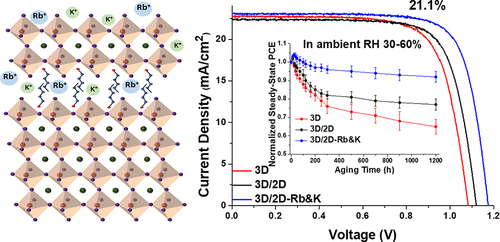当前位置:
X-MOL 学术
›
Nano Lett.
›
论文详情
Our official English website, www.x-mol.net, welcomes your feedback! (Note: you will need to create a separate account there.)
Alkali Cation Doping for Improving the Structural Stability of 2D Perovskite in 3D/2D PSCs.
Nano Letters ( IF 10.8 ) Pub Date : 2020-01-22 , DOI: 10.1021/acs.nanolett.9b04661 Chang Liu 1, 2 , Jingsong Sun 3 , Wen Liang Tan 3 , Jianfeng Lu 2 , Thomas R Gengenbach 4 , Christopher R McNeill 3 , Ziyi Ge 1 , Yi-Bing Cheng 3, 5 , Udo Bach 2
Nano Letters ( IF 10.8 ) Pub Date : 2020-01-22 , DOI: 10.1021/acs.nanolett.9b04661 Chang Liu 1, 2 , Jingsong Sun 3 , Wen Liang Tan 3 , Jianfeng Lu 2 , Thomas R Gengenbach 4 , Christopher R McNeill 3 , Ziyi Ge 1 , Yi-Bing Cheng 3, 5 , Udo Bach 2
Affiliation

|
3D/2D hybrid perovskite systems have been intensively investigated to improve the stability of perovskite solar cells (PSCs), whereas undesired crystallization of 2D perovskite during the film formation process could undermine the structural stability of 2D perovskite materials, which causes serious hysteresis of PSCs after aging. This issue is, however, rarely studied. The stability study for 3D/2D hybrid systems to date is all under the one-direction scan, and the lack of detailed information on the hysteresis after aging compromises the credibility of the stability results. In this work, by correlating the hysteresis of the hybrid PSCs with the 2D crystal structure, we find that the prompt 2D perovskite formation process easily induces numerous crystal imperfections and structural defects. These defects are susceptible to humidity attack and decompose the 2D perovskite to insulating long-chain cations and 3D perovskite, which hinder charge transfer or generate charge accumulation. Therefore, a large hysteresis is exhibited after aging the 3D/2D hybrid PSCs in an ambient environment, even though the reverse-scan power conversion efficiency (PCE) is found to be well-preserved. To address this issue, alkali cations, K+ and Rb+, are introduced into the 2D perovskite to exquisitely modulate the crystal formation, which gives rise to a higher crystallinity of 2D perovskite and a better film morphology with fewer defects. We achieved PCE beyond 21% due to the preferable charge transfer process and reduced nonradiative recombination losses. The structural features also bring about impressive moisture stability, which results in the corresponding PSCs retaining 93% of its initial PCE and negligible hysteresis after aging in an ambient atmosphere for 1200 h.
中文翻译:

碱性阳离子掺杂可改善3D / 2D PSC中2D钙钛矿的结构稳定性。
已经对3D / 2D混合钙钛矿体系进行了深入研究,以提高钙钛矿太阳能电池(PSC)的稳定性,而2D钙钛矿在成膜过程中发生的不希望的结晶会破坏2D钙钛矿材料的结构稳定性,这会导致PSC在使用后出现严重的滞后现象。老化。但是,很少研究此问题。迄今为止,针对3D / 2D混合系统的稳定性研究都是在单向扫描下进行的,并且老化后缺乏详细的磁滞信息会损害稳定性结果的可信度。在这项工作中,通过将杂化PSC的磁滞与2D晶体结构相关联,我们发现迅速的2D钙钛矿形成过程很容易引起许多晶体缺陷和结构缺陷。这些缺陷易受潮气侵蚀,并使2D钙钛矿分解为绝缘的长链阳离子和3D钙钛矿,从而阻碍电荷转移或产生电荷积聚。因此,即使发现可以很好地保留反向扫描功率转换效率(PCE),在3D / 2D混合PSC在环境环境中老化后仍会显示出较大的滞后现象。为了解决这个问题,将碱金属阳离子K +和Rb +引入2D钙钛矿中,以精确地调节晶体的形成,从而提高了2D钙钛矿的结晶度,并改善了薄膜形态,减少了缺陷。由于优选的电荷转移过程和减少的非辐射复合损失,我们实现了超过21%的PCE。结构特征还带来了令人印象深刻的水分稳定性,
更新日期:2020-01-23
中文翻译:

碱性阳离子掺杂可改善3D / 2D PSC中2D钙钛矿的结构稳定性。
已经对3D / 2D混合钙钛矿体系进行了深入研究,以提高钙钛矿太阳能电池(PSC)的稳定性,而2D钙钛矿在成膜过程中发生的不希望的结晶会破坏2D钙钛矿材料的结构稳定性,这会导致PSC在使用后出现严重的滞后现象。老化。但是,很少研究此问题。迄今为止,针对3D / 2D混合系统的稳定性研究都是在单向扫描下进行的,并且老化后缺乏详细的磁滞信息会损害稳定性结果的可信度。在这项工作中,通过将杂化PSC的磁滞与2D晶体结构相关联,我们发现迅速的2D钙钛矿形成过程很容易引起许多晶体缺陷和结构缺陷。这些缺陷易受潮气侵蚀,并使2D钙钛矿分解为绝缘的长链阳离子和3D钙钛矿,从而阻碍电荷转移或产生电荷积聚。因此,即使发现可以很好地保留反向扫描功率转换效率(PCE),在3D / 2D混合PSC在环境环境中老化后仍会显示出较大的滞后现象。为了解决这个问题,将碱金属阳离子K +和Rb +引入2D钙钛矿中,以精确地调节晶体的形成,从而提高了2D钙钛矿的结晶度,并改善了薄膜形态,减少了缺陷。由于优选的电荷转移过程和减少的非辐射复合损失,我们实现了超过21%的PCE。结构特征还带来了令人印象深刻的水分稳定性,



























 京公网安备 11010802027423号
京公网安备 11010802027423号